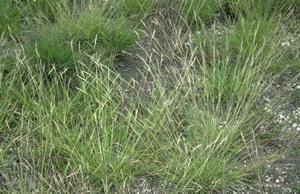Printed at http://www.newmoonnursery.com/index.cfm/
Danthonia spicata
Poverty oat grass
Native to North America
FIRST IMPRESSIONS: Danthonia spicata is a petite cool season perennial grass with dense tufted foliage. Leaves from the current season are wiry and bluish green. Twisted older leaves develop a bronzy hue and are retained at the base of each clump. In late spring delicate flower panicles rise above the foliage. This grass thrives in sunny exposures with poor dry soil.
HABITAT & HARDINESS: Danthonia spicata occurs in most parts of Canada and south into northern Mexico. The species ranges throughout the United States except for California, Nevada and Utah.
Plants are indigenous to dry upland sites including open woods, dry prairies, limestone and sandstone glades, balds, thinly wooded bluffs, rocky slopes and roadsides. In general, this grass prefers dry uplands with sparse vegetation and few fallen leaves. This species occurs commonly in ecosystems maintained by frequent fires.
This grass is hardy from USDA Zones 3-8.
PLANT DESCRIPTION: Danthonia spicata is a clump forming cool season grass with twisted wiry foliage. This grass holds soil with its vigorous fiberous roots and expands slowly from short rhizomes.
Leaf blades are medium green or bluish-green, 4-6” long and about 1/16” wide. They are generally smooth with a margin that rolls up. Old leaves develop a buff color and persist at the base of the clumps.
Leafless culms rise above the foliage bearing narrow panicles with 2-13 spikelets. The spikelets have twisted pubescent awns.
Plants attain 1-2’ height with 1’ spread.
CULTURAL & MAINTENANCE NEEDS: Danthonia spicata prospers in full sun or part sun and infertile dry sandy or rocky soil. Plants tolerate drought and alkaline soils and will decline if soil it too fertile.
This grass also declines if shaded by taller plants. It is usually associated with sites that are frequently burned to suppress competing vegetation.
Plants need little maintenance except to be cut or burned to the ground in late winter.
This grass is relatively pest free but does host caterpillars of Leonard’s skipper and Indian skipper. Foliage is not palatable to deer and other herbivores.
LANDSCAPE USES: Useful as an Accent, Groundcover or for Erosion Control. Danthonia spicata is often used as part of a Grouping or Mass Planting. It provides Showy Flowers, Winter Interest and is a candidate for Green Roofs and Native Lawns. Plants are appropriate for Water-wise Landscapes, Low Maintenance Plantings, Meadow or Prairie Gardens, Perennial Borders, Rock Gardens and Restoration Projects.
COMPANION & UNDERSTUDY PLANTS: Try pairing Danthonia spicata with Asclepias tuberosa, Baptisia tinctoria, Carex pensylvanica, Monarda punctata, Schizachrium scoparium, Solidago rigida or Tradescantia ohioensis.
Schizachyrium scoparium and Bouteloua curtipendula are slightly taller grasses with similar cultural needs that can be substituted if needed.
TRIVIA: The most noticeable florets are held on flexible stalks above the foliage and are wind pollinated. This grass also has cleistogamous florets that are hidden inside the leaf sheathes. These florets are self-fertilized and they pollinate themselves under cover.
Danthonia spicata is easy to identify due to its diminutive size and dense tufts of curly basal leaves.
This grass is considered to be a pioneer species. Seed survive for long periods buried in the soil. After disturbance or burning, germination is stimulated and seedlings colonize the bare ground.
Height:
1-2 ftSpread:
1 ftSpacing:
18-24 inUSDA Hardiness Zone:
3-8Bloom Color:
GreenDanthonia spicata Characteristics
Attracts Wildlife
- Butterflies
Attributes
- Dried Flower
- Cut Flower
Exposure
- Full Sun to Full Shade
Flowering Months
- June
Foliage Color
- Green
Grass Season
- Cool Season Grass
Groundcover Foot-Traffic Tolerances
- Moderate
Lawn Replacement or Groundcover
- Groundcover
- Lawn Replacement
Soil Moisture Preference
- Dry

